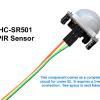Rails and Trails Imaging
Model RR - Animation and Special Effects
Localized Sound Effects
My vision is to utilize a servo motor and sound card to animate a locomotive taking on water. This project is not started.
Thunderstorm Ignites a Forest Fire
This attraction is more elaborate to create. It will utilize front video projection, strobes, sound, lots of LED's, smoke and even a fire fighting train.
Operating Spar Tree
To animate the logging camp scene, I'm designing a spar tree that lifts and lowers logs and also rotates. This will require servo, stepping motor, and sound card.
City Lights and Animated Signs
My idea of a city filled with life is animated signs and building lights that are constantly changing. This will utilize Miller Signs, Arduino controlled LED's, and sound cards.
Having some animation and special effects on a layout adds great visitor interest as well as providing challenges to the skills and imagination of the builder. As usual, it all starts with day and night time lighting, but then my imagination took over. As I learned more about servos, Arduino, and other sensor and control circuits, I wanted to do more. Here are some of my ideas.
These basic tools can be used to create many types of movement, sound and special effects.
Smoke Generator Using Vape Heating Units
On any model railroad, adding localized sound effects can add to the realism by stimulating another one of our senses. I will use babbling brooks, waterfalls, cows, surf and sea gulls just to mention a few. Since these are associated with very specific scenes on the layout, the sound needs only be present when a viewer is in the proximity. So, I combined available technology with a trigger circuit to make it happen. The sound modules are available from Ngineering.com, the PIR motion sensors are available on Ebay, and I will show you how to built the trigger circuit and connect the components.
To play slide show, click on the 1st picture.
I have never been happy with the Sleuth Smoke Units -too expensive, need lots of refilling, and generates excessive heat. I got this idea of generating smoke using an ECigarette with glycerin as fuel. This produces lower heat, uses inexpensive fuel, and produces enough smoke to support many chimneys, produce a house on fire, a forest fire, etc. A 3.7Vdc supply voltage is required for the heating coils, which I show you how to build. All components are available at a reasonable price.
Working Water Tanks
To play slide show, click on the 1st picture.




























